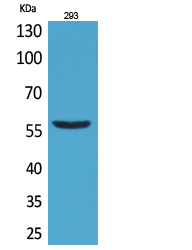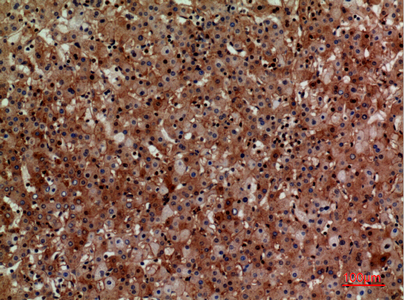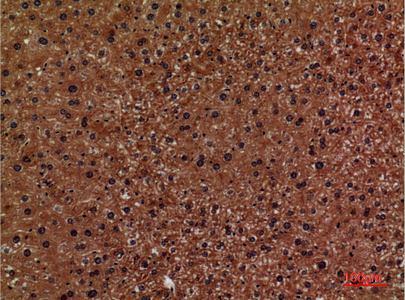产品名称
CD276 Rabbit Polyclonal Antibody
别名
CD276; B7H3; PSEC0249; CD276 antigen; 4Ig-B7-H3; B7 homolog 3; B7-H3; Costimulatory molecule; CD276
存储缓冲液
Liquid in PBS containing 50% glycerol, 0.5% BSA and 0.02% New type preservative N.
Human Gene Link
http://www.ncbi.nlm.nih.gov/sites/entrez?db=gene&term=80381
Human Swissprot No.
Q5ZPR3
Human Swissprot Link
http://www.uniprot.org/uniprotkb/Q5ZPR3/entry
Mouse Gene Link
http://www.ncbi.nlm.nih.gov/sites/entrez?db=gene&term=102657
Mouse Swissprot No.
Q8VE98
Mouse Swissprot Link
http://www.uniprot.org/uniprot/Q8VE98
Rat Gene Link
http://www.ncbi.nlm.nih.gov/sites/entrez?db=gene&term=315716
Rat Swissprot Link
http://www.uniprot.org/uniprot/Q7TPB4
免疫原
The antiserum was produced against synthesized peptide derived from the Internal region of human CD276. AA range:271-320
特异性
CD276 Polyclonal Antibody detects endogenous levels of CD276 protein.
稀释度
WB 1:500 - 1:2000. IHC-p: 1:100-300 ELISA: 1:20000.. IF 1:50-200
宿主
Polyclonal, Rabbit,IgG
背景介绍
The protein encoded by this gene belongs to the immunoglobulin superfamily, and thought to participate in the regulation of T-cell-mediated immune response. Studies show that while the transcript of this gene is ubiquitously expressed in normal tissues and solid tumors, the protein is preferentially expressed only in tumor tissues. Additionally, it was observed that the 3' UTR of this transcript contains a target site for miR29 microRNA, and there is an inverse correlation between the expression of this protein and miR29 levels, suggesting regulation of expression of this gene product by miR29. Alternatively spliced transcript variants encoding different isoforms have been found for this gene. [provided by RefSeq, Sep 2011],
组织表达
Ubiquitous but not detectable in peripheral blood lymphocytes or granulocytes. Weakly expressed in resting monocytes. Expressed in dendritic cells derived from monocytes. Expressed in epithelial cells of sinonasal tissue. Expressed in extravillous trophoblast cells and Hofbauer cells of the first trimester placenta and term placenta.
细胞定位
Membrane ; Single-pass type I membrane protein .
信号通路
Cell adhesion molecules (CAMs);
功能
function:May participate in the regulation of T-cell-mediated immune response. May play a protective role in tumor cells by inhibiting natural-killer mediated cell lysis as well as a role of marker for detection of neuroblastoma cells. May be involved in the development of acute and chronic transplant rejection and in the regulation of lymphocytic activity at mucosal surfaces. Could also play a key role in providing the placenta and fetus with a suitable immunological environment throughout pregnancy. Both isoform 1 and isoform 2 appear to be redundant in their ability to modulate CD4 T-cell responses. Isoform 2 is shown to enhance the induction of cytotoxic T-cells and selectively stimulates interferon gamma production in the presence of T-cell receptor signaling.,induction:By LPS in monocytes and by ionomycin in T and B lymphocytes. Up-regulated in cells mediating rejection of human transplants.,miscellaneous:B7-H3 locus underwent genomic duplication leading to tandemly repeated immunoglobulin-like V and C domains (VC domains). The dominantly expressed human B7-H3 isoform contains tandemly duplicated VC domains. In contrast, mouse B7-H3 transcript contains only one single VC domain form due to an exon structure corresponding to V domain-(pseudoexon C)-(pseudoexon V)-C domain. This duplication appearing in primates is suggested to be very recent supporting a model of multiple independent emergence of tandem VC repeats within human and monkey species.,similarity:Belongs to the immunoglobulin superfamily. BTN/MOG family.,similarity:Contains 2 Ig-like C2-type (immunoglobulin-like) domains.,similarity:Contains 2 Ig-like V-type (immunoglobulin-like) domains.,subunit:Interacts with TREML2 and this interaction enhances T-cell activation.,tissue specificity:Ubiquitous but not detectable in peripheral blood lymphocytes or granulocytes. Weakly expressed in resting monocytes. Expressed in dendritic cells derived from monocytes. Expressed in epithelial cells of sinonasal tissue. Expressed in extravillous trophoblast cells and Hofbauer cells of the first trimester placenta and term placenta.,
纯化
The antibody was affinity-purified from rabbit antiserum by affinity-chromatography using epitope-specific immunogen.


.jpg)

.jpg)

